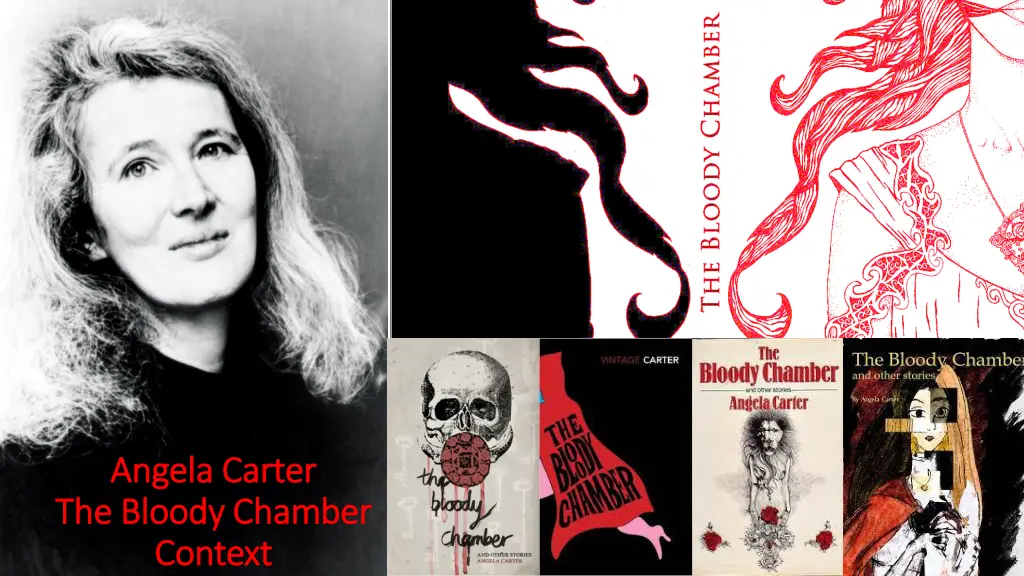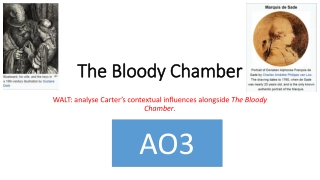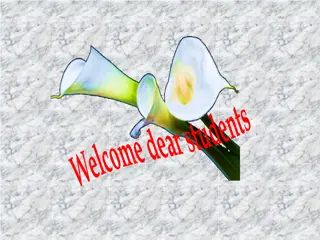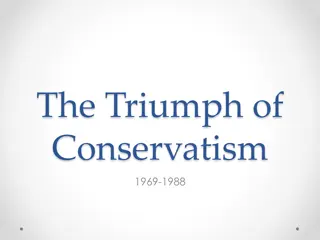
Exploring Angela Carter's Life, Works, and Literary Contributions
Dive into the intriguing life of Angela Carter, an English novelist known for her feminist, magical realism, and picaresque works. Uncover the major events in Carter's life, simultaneous historical contexts, her significant literary works, and the impact of her feminist ideologies. Analyze the conventions of fairy tales, short stories, and gothic writing as explored by Carter. Prepare for an insightful journey through the realms of literature and feminism.
Download Presentation

Please find below an Image/Link to download the presentation.
The content on the website is provided AS IS for your information and personal use only. It may not be sold, licensed, or shared on other websites without obtaining consent from the author. If you encounter any issues during the download, it is possible that the publisher has removed the file from their server.
You are allowed to download the files provided on this website for personal or commercial use, subject to the condition that they are used lawfully. All files are the property of their respective owners.
The content on the website is provided AS IS for your information and personal use only. It may not be sold, licensed, or shared on other websites without obtaining consent from the author.
E N D
Presentation Transcript
Angela Carter Angela Carter The Bloody Chamber The Bloody Chamber Context Context
In groups, research and present information In groups, research and present information (next lesson) on the following topics (next lesson) on the following topics 1. Angela Carter: major events in Carter s life; simultaneous historical events of contextual importance; Carter s major literary works (with brief summaries) 2. Feminism (the feminist movement and how this has developed over time. 1st/2nd/3rdwave) 3. Conventions of Fairy Tales 4. Conventions of short stories 5. Conventions of Gothic writing
For next lesson: For next lesson: Presentation ready Have read The Bloody Chamber Have read the Introduction at the start Lesson 1: Outline and Introduction to the Gothic: Botting WALT: understand and apply early definitions of the Gothic to Carter s work. Task 1- Ask students to consider what women are usually like in old-fashioned horror films. You could link this to what students know about the roles of women in Rossetti s time. Task 2- Read the opening to The Bloody Chamber and consider how the female characters are presented in it. What stereotypes about men and women does it present? Task 3- Discuss the following questions in relation to your reading. Is Carter s work feminist? How does she subvert Gothic s normal generic conventions? Is the Gothic subversive as a genre in itself? Task 4- read the extracts from the review of the Monk and unpick their meaning. These will form a reliable set of quotations to use throughout lessons and for students to compare to the unseen extracts so that they can gain the three marks for context that are available.
Angela Carter Angela Carter Angela Olive Carter-Pearce (n e Stalker; 7 May 1940 16 February 1992) who published as Angela Carter, was an English novelist, short story writer and journalist, known for her feminist, magical realism, and picaresque works. In 2008, The Times ranked Carter tenth in their list of "The 50 greatest British writers since 1945". In 2012, Nights at the Circus was selected as the best ever winner of the James Tait Black Memorial Prize.
Carter Biography Carter Biography Carter was evacuated as a child to live in Yorkshire with her maternal grandmother. As a teenager she battled against anorexia. After attending Streatham and Clapham High School, in south London, she began work as a journalist on the Croydon Advertiser,following in the footsteps of her father. Carter attended the University of Bristol where she studied English literature. She married twice, first in 1960 to Paul Carter, divorcing in 1972. In 1969, she used the proceeds of her Somerset Maugham Award to leave her husband and relocate for two years to Tokyo, where she claims in Nothing Sacred (1982) that she "learnt what it is to be a woman and became radicalised". In 1979, both The Bloody Chamber, and her influential essay, The Sadeian Woman and the Ideology of Pornography, appeared. In the essay, according to the writer Marina Warner, Carter "deconstructs the arguments that underlie The Bloody Chamber. It's about desire and its destruction, the self-immolation of women, how women collude and connive with their condition of enslavement. She was much more independent-minded than the traditional feminist of her time."[7]
The The Sadeian Sadeian Woman and the Ideology of Woman and the Ideology of Pornography Pornography The Sadeian Woman and the Ideology of Pornography is a 1978 non-fiction book by Angela Carter. The book is a feminist re- appraisal of the work of the Marquis de Sade, who had been criticized by earlier feminist theorists such as Andrea Dworkin. Carter sees de Sade as being the first writer to see women as more than mere breeding machines, as more than just their biology and, as such, finds him liberating.
Bloody Chamber Styles and Themes Angela Carter's short stories challenge the way women are represented in fairy tales, yet retain an air of tradition and convention through her voluptuously descriptive prose. For example, in the opening tale "The Bloody Chamber" which is a retelling of Bluebeard, Carter plays with the conventions of canonical fairy tales; instead of the heroine being rescued by the stereotypical male hero, she is rescued by her mother. Carter effectively draws out the theme of feminism by contrasting traditional elements of Gothic fiction which usually depicted female characters as weak and helpless with strong female protagonists.By contrasting the barren and horrific atmosphere found typically within the Gothic to the strong heroines of her story, Carter is able to create sexually liberated female characters that are set against the more traditional backdrop of the fairy tale. In doing so, Carter reinvents the outdated conventions of fairy tales and offers insight on the archetypes and stereotypes of women in these well-known and celebrated stories. The stories deal with themes of women's roles in relationships and marriage, their sexuality, coming of age and corruption. Stories such as "The Bloody Chamber" and "The Company of Wolves" explicitly deal with the horrific or corrupting aspects of marriage and/or sex and the balance of power within such relationships. Themes of female identity are explored in the "Beauty and the Beast" stories such as "The Tiger's Bride". In one instance, Beauty: the story's heroine, is described as removing the petals from a white rose as her father gambles her away, a seeming representation of the stripping away of the false layers of her personality to find her true identity; an image that finds a mirror in the story's fantastical conclusion. As a whole, The Bloody Chamber can be treated as a collection of short stories that speak to a bigger narrative that deals with issues of feminism and metamorphosis instead of a set of individual tales. Although each particular narrative deals with a different set of characters, the 'oppressed female seeking liberation' is a common theme and concept that is explored throughout the collection. The characters seem to blend into each other and become indistinguishable from one another when recognising this theme in the text. The stories are updated to more modern settings. The exact time periods remains vague, but they are clearly anchored intentionally. For example, in "The Bloody Chamber" the existence of transatlantic telephone implies a date 1930 or later. On the other hand, the mention of painters such as Gustave Moreau and Odilon Redon, and of fashion designer Paul Poiret (who designs one of the heroine's gowns) all suggest a date before 1945. "The Lady of the House of Love" is clearly set on the eve of the First World War, and the young man's bicycle on which he arrives at the tradition-bound vampire's house is a symbol of the encroaching modernity which fundamentally altered European society after 1914.






















